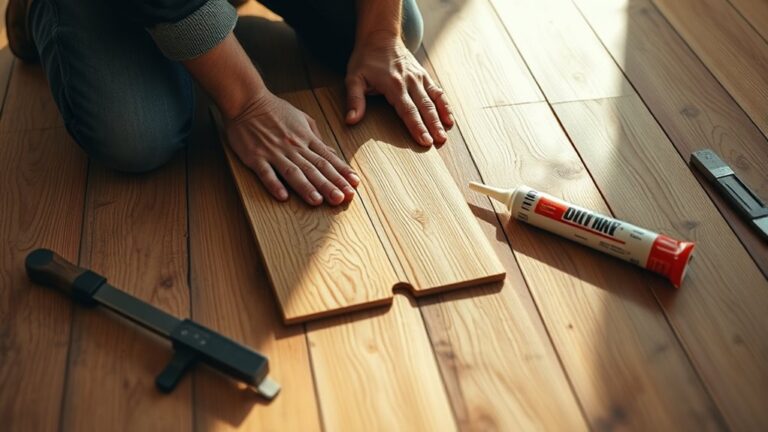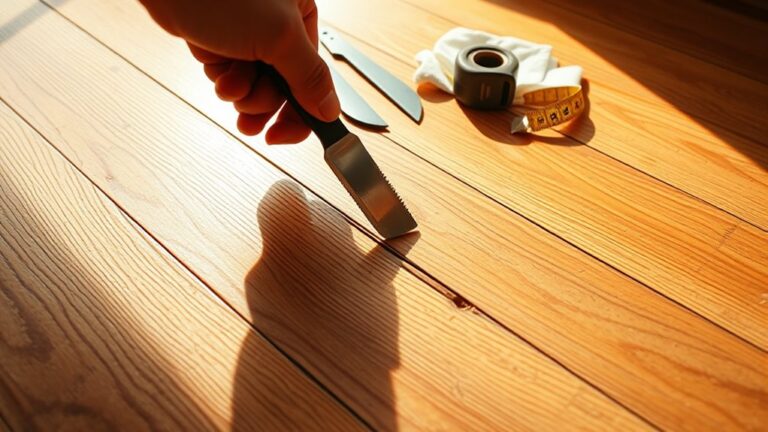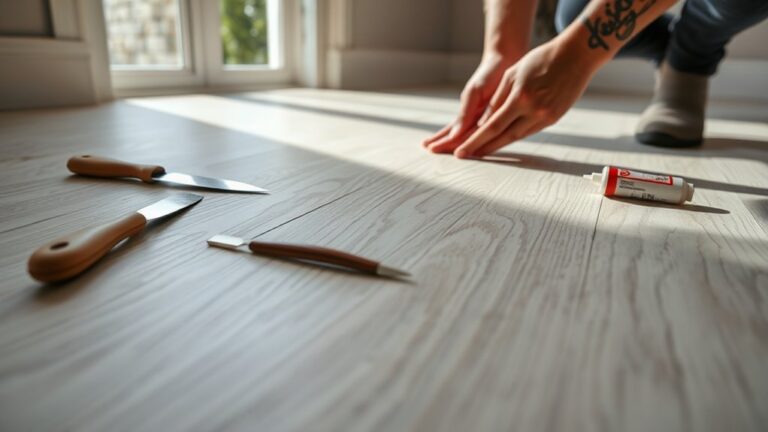If you spot white water stains on your wood floor, try using a hairdryer on low heat with a cloth over the mark to evaporate trapped moisture quickly. For mild stains, gently rub non-gel white toothpaste in circles, then wipe clean. Darker stains respond to equal parts vinegar and olive oil rubbed along the grain. Persistent marks may need light sanding and refinishing. Keep going to uncover effective methods for lasting restoration and protection.
Identifying Different Types of Water Stains on Wood Floors

How can you tell what type of water stain is affecting your wood sol? Accurate stain identification is vital for effective treatment and preventing further water damage. White stains typically indicate surface moisture trapped under the finish, while dark stains often signal deeper damage where water has penetrated the wood fibers. You might also encounter rings from spilled liquids or persistent blotches from prolonged exposure. By closely examining the color, texture, and location of the stain, you can determine the severity and depth of the water damage. This understanding empowers you to choose the right removal method confidently, ensuring your wood floor regains its natural beauty without unnecessary repairs or replacements. Stay vigilant—early identification is your first step to freedom from stubborn water stains.
Using Heat to Lift White Water Stains
When you spot white water stains on your wood floor, heat can be an effective tool to lift the moisture trapped beneath the finish. The key is using controlled heat sources to encourage moisture absorption back into the wood fibers. Here’s how to do it safely:
- Choose a low-heat source like a hairdryer or iron set to a low setting.
- Place a clean, dry cloth over the stain to protect the finish.
- Gently apply heat in short intervals, moving constantly to avoid scorching.
- Check progress frequently; stop once the white haze fades.
This method helps evaporate trapped moisture, restoring your floor’s appearance without harsh chemicals. Use heat carefully to maintain your wood’s integrity and enjoy a stain-free surface.
Applying Toothpaste for Mild Water Marks

Try applying toothpaste to mild water marks as a simple and effective solution. For toothpaste application, choose a non-gel, white paste. Gently rub a small amount onto the stain with a soft cloth in circular motions. This technique helps break down the moisture trapped in the wood, aiding stain removal without damaging the finish. After rubbing for a minute, wipe clean with a damp cloth and dry thoroughly.
| Étape | But |
|---|---|
| Select toothpaste | Avoid gels; use white paste |
| Apply gently | Prevent finish damage |
| Rub in circles | Loosen stain |
| Wipe and dry | Remove residue, prevent moisture |
This method offers a quick, low-risk option to restore your wood floors’ natural beauty.
Treating Dark Water Stains With Vinegar and Olive Oil
To tackle dark water stains, mix equal parts vinegar and olive oil for a natural cleaning solution. Apply the mixture sparingly with a soft cloth, rubbing gently along the wood grain to avoid damage. Remember to test a small area first and wipe off any excess to prevent residue buildup.
Vinegar and Oil Mix
Although dark water stains can be stubborn, a mixture of vinegar and olive oil offers an effective way to diminish their appearance on wood floors. You can harness the vinegar benefits for gently breaking down mineral deposits while the oil properties restore moisture and shine. Here’s how this combo works:
- Vinegar’s acidity lifts the stain without harsh chemicals.
- Olive oil nourishes the wood, preventing dryness and cracking.
- The mix softens dark water marks, making them less visible.
- It leaves your floors conditioned, enhancing their natural beauty.
Using this natural blend gives you control over your wood’s care, avoiding costly refinishing. It’s a straightforward, powerful method you can rely on to refresh your floors and maintain their freedom from water damage.
Application Tips and Tricks
Mastering the right method for applying the vinegar and olive oil mix can make all the difference in successfully treating dark water stains on your wood floors. Start by mixing equal parts of white vinegar and olive oil to create an effective cleaning solution. Use a soft cloth to apply the mix, working it gently into the stain with circular motions. Avoid saturating the wood to prevent damage. Let the solution sit for a few minutes to penetrate the stain, then buff the area with a clean, dry cloth to restore shine. Remember, consistent wood care is key—test the solution on a hidden spot first to verify it won’t harm your floor’s finish. This targeted approach frees you from stubborn stains while preserving your wood’s natural beauty.
Sanding and Refinishing for Persistent Stains

If water stains won’t budge, sanding is your next step. Start with medium-grit sandpaper to remove the damaged layer, then finish with fine grit for a smooth surface. After sanding, apply a matching stain and sealant to restore your floor’s finish and protect it from future damage.
Choosing Sandpaper Grit
Selecting the right sandpaper grit is essential when sanding wood floors to remove water stains effectively. Your choice directly impacts sanding techniques and the quality of the finish. Start with a grit that balances efficiency and floor protection.
Consider these key points for grit selection:
- Begin with 60-80 grit to remove deep stains without damaging the wood.
- Progress to 100-120 grit for smoothing the surface after initial sanding.
- Avoid using overly coarse grits, which can cause scratches.
- Finish with fine grit (150-180) to prepare for refinishing and guarantee a smooth surface.
Refinishing Techniques Overview
Once you’ve chosen the appropriate sandpaper grits, the next step is to focus on sanding and refinishing techniques that tackle persistent water stains. Start by sanding the affected area evenly to remove the damaged finish and surface discoloration. Use progressively finer grits to smooth the wood without causing deep scratches. After sanding, clean the dust thoroughly before applying your chosen refinishing methods. Options include staining, sealing, or applying a polyurethane finish to restore the wood’s natural beauty and protect it from future damage. Proper floor restoration requires patience and attention to detail, but it’s the most effective way to eliminate stubborn water stains and rejuvenate your wood floors. By mastering these refinishing methods, you reclaim your floor’s appearance and maintain the freedom to enjoy a flawless surface.
Preventing Future Water Damage on Wood Floors
Although water stains can often be removed, preventing future damage is essential to preserving your wood floors’ appearance and longevity. You can protect your floors by taking proactive measures that minimize moisture exposure and maintain ideal conditions.
Here’s what you should do:
- Apply waterproof coatings to create a durable barrier against spills and humidity.
- Monitor and maintain humidity control to prevent wood expansion and contraction.
- Wipe up spills immediately to avoid water seepage and staining.
- Use area rugs in high-traffic or moisture-prone areas to shield the wood surface.
Best Practices for Maintaining Your Wood Floor’s Finish
Maintaining your wood floor’s finish requires consistent care and attention to protect its shine and durability. Stick to a maintenance schedule that includes regular sweeping or vacuuming to remove dirt and grit, which can scratch the surface. Use cleaning products specifically designed for wood floors—avoid harsh chemicals that strip the finish or cause damage. When mopping, opt for a damp, not wet, cloth to prevent moisture buildup. Periodically, apply a wood floor polish or restorer recommended by the manufacturer to revive luster and add a protective layer. Protect your floors by using furniture pads and area rugs in high-traffic zones. Following these best practices guarantees your wood floor remains beautiful and free from premature wear, giving you the freedom to enjoy its natural elegance for years.




